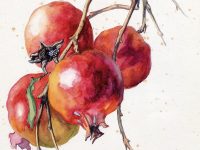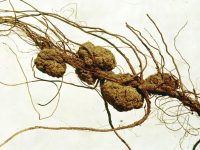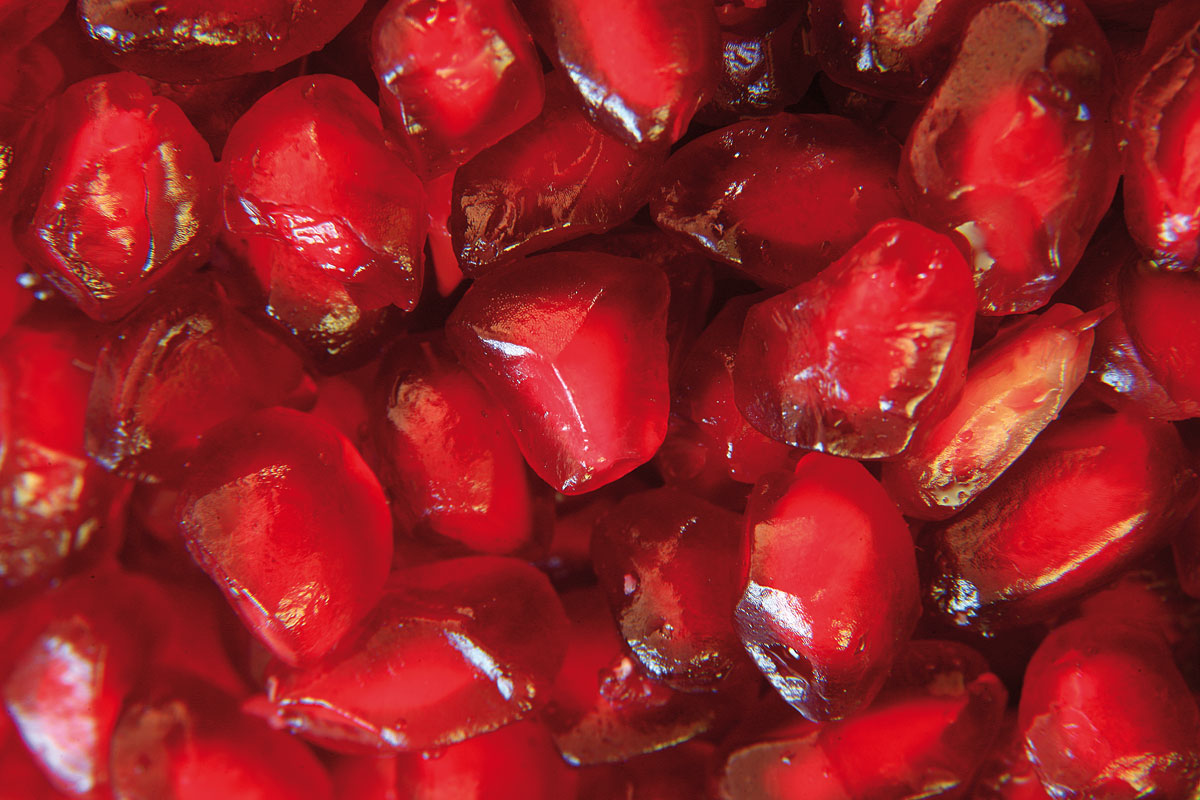
The pomegranate tree appears to be native from the shores of the Caspian Sea, the plains in Iran and the mountains in Kurdistan and Afganistan, where it grows wild in rocky places. From there, Phoenicians spread its farming all around the shores of the Mediterranean. Rests of the fruit, considered a symbol of love and fertility have been found in some tombs in Egypt. The tree was consecrated to the god Rimmel in Siria and Aphrodite in Greece. Phoenicians planted it specifically around Carthage, thus the name «apple of Carthage» (Malum punicum) given by the Romans. Later we find that Columella called it Malum granatum, or grain apple, from which the names in Romance languages have evolved: magrana in Catalan, melagrana in Italian, grenade in French, granada in Spanish and the English pomegranate.
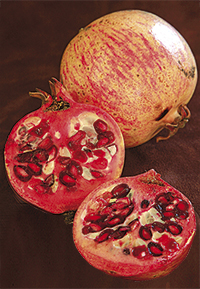
Photo: V. Rodríguez
The pomegranate tree is a thick tree or bush, more or less thorny, of opposing and shiny leaves. It blooms in early summer, with solitary flowers, wide and very attractive. Through this season, the ovary matures in each of these flowers until it gives way, in autumn, to a pomegranate. It is a big spherical fruit, which opens irregularly when it is ripe. It is wrapped in a skin that goes from green, through yellow, to pink and red. The grains are arranged in different sheets, each of them corresponding to a carpel. Every grain is of the balausta species, that is, they have a juicy exterior and a dry internal side, quite easy to feel when eating them.
Currently, the pomegranate crops in the region of Valencia have taken refuge in the gardens of the Palmeral d’Elx and the Baix Segura areas, where most of the 2,300 dedicated hectares in the region are located. During the last years, in the counties of Fresno and Tulare (California, USA), big crops were set, and they are already exporting their production all around the world.
Between you and me, in the rest of the region of Valencia, fruit of the old pomegranate trees stays more and more on the trees because less and less people appreciates it. There are not any more farmers of those who made sure they ate pomegranates in farming season because they thought it gave them strength to carry the plough handle. It is few that remember the virtues of the pomegranate tree. One of the most important says that its boiled roots make for a potion which, drank while fasting, was very efficient in expelling intestinal worms like the tapeworm. The skin and the internal carpels of the wild fruit have a similar action. Other properties, such as using wild pomegranate juice to treat throat conditions or preparing a delicious drink called grenadine, are only memory in remote corners of today’s world.
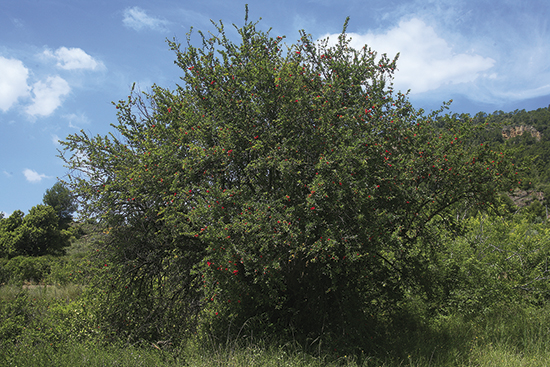
There are currently 2,300 cultivated hectares of pomegranate in Valencia. Most of the areas in the region, other than Elx and Baix Segura, have abandoned their culture. / Photo: V. Rodríguez
«Every grain is of the balausta species, that is, they have a juicy exterior and a dry internal side, quite easy to feel when eating them»
Some stories talk about the symbolic link between this fruit and the Christian tradition of body and soul. There was a popular tale that was told in November when we were kids. It said that the pomegranate represents Purgatory and the grains were little souls. And our grandmothers told us that for each grain eaten in the grace of God, a soul was saved from Purgatory. This was used to make us think about our behaviour and obedience. Conversely, I have later read other tales from different places, where the belief is expressed that on November 2nd, Day of the Dead, we should not eat pomegranates as a show of respect towards souls, because that was their holiday.
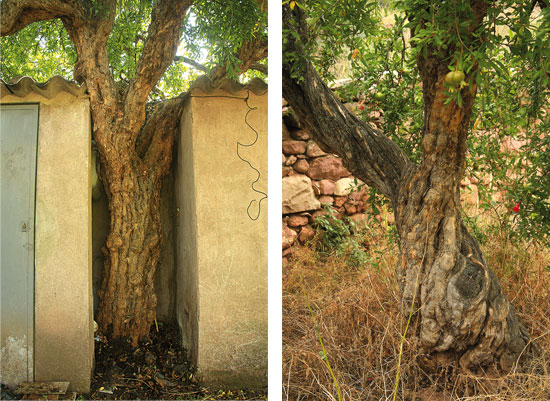
It is possible to find hundred-years-old pomegranate trees in some villages in Valencian mountains. That is the case of Olocau, the town where the trees in these photos can be found. Left to right: pomegranate tree between buildings in the garden of Nassio and Tona tree in the garden of Bajus. / Photo: V. Rodríguez
Another legend similarly repeated with other trees is the one presented by Joan Armades in his Costumari català (Catalan customs book). He narrates how, on their way to the temple, when the Mother of God was going to introduce Jesus, she felt tired and sat at the feet of a pomegranate tree. The tree, upon seeing that its shadow served such divine people, hurried and lowered its branches so they would shelter them as a canopy. And the Mother of God, when she got up, blessed it. So that is why the pomegranate tree lets its branches drop to provide a useful shadow; although farmers say it is because of the weight of pomegranates.
Carlos Mendoza (1993), indescribable author of Leyenda de las plantas (Legend of the plants), tells us that «very sensible authors» think it was not apples, but pomegranates, what Eve offered Adam and, generalising more, that whenever there is an issue of love or marriage, we have to understand they are not talking about apples, but pomegranates. Finally, the same author says that the pomegranate is a tree about which there is a lot to say, by it is not advisable to say it all «and that is why, as many other distinguished representatives who only say ‘yes’ and ‘no’, I will hush, and not tell very good, or very bad things» (por lo qual, como tantos ilustres diputados que sólo dicen ‘sí’ o ‘no’, me callaré muy buenas, o malas cosas).
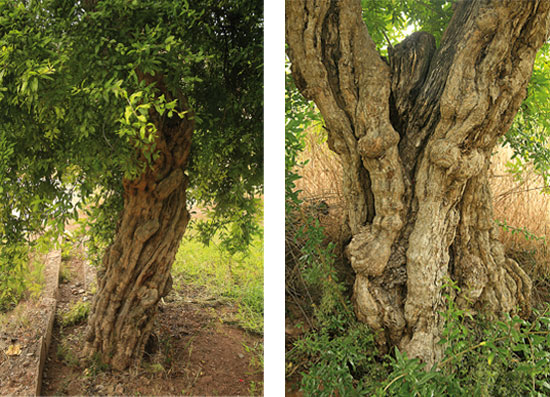
Left to right: Tree of Pepe Navarro in the garden of Bajus and pomegranate tree of Maria Rita Zurriaga in Parada l’Omet. / Photo: V. Rodríguez
We will also keep quiet and not tell any more things about this tree written by mythologists, so we will not exhaust the reader. We will just do a final consideration. In Camp de Túria, most of remaining pomegranate trees are more than a hundred years old, relics of gardens that maintained woodland richness for centuries, where, among others, pomegranate trees have grown. The same way that family agriculture fades away, also these gardens are receding. Look at some of the pictures in this article, in which some old pomegranate trees appear. And I think to myself why does a tree with so many stories behind disappear? Is there no space in our daily world for these things?
REFERENCES
Agustí, M., 1988. Llibre dels secrets d'agricultura, casa rústica i pastoril. Alta Fulla. Barcelona.
Anònim, 1995. Les mil i una nits. Cinca, D. i M. Castell (trad.). Proa. Barcelona.
Aranegui, C.; Mata, C. i J. Pérez Ballester, 1997. Damas y caballeros en la ciudad ibérica. Cátedra. Madrid.
Graves, R., 1992. Rey Jesús. Edhasa. Barcelona.
Mendoza, C., 1993. La leyenda de las plantas. Alta Fulla. Barcelona.
Sanchis Guarner, M., 1983. Els pobles valencians parlen uns dels altres, iv. Obra Completa. Edicions 3i4. Valencia.
Shakespeare, W., 1959. Romeo i Julieta; Otel·lo; Macbeth. Sagarra, J. M. de (trad.). Alpha. Barcelona.

